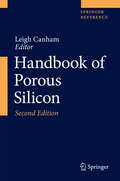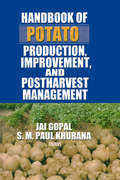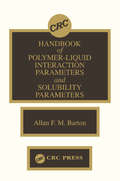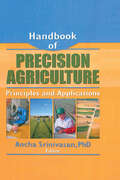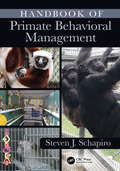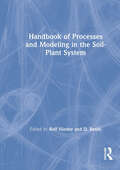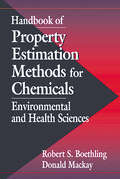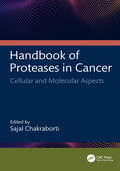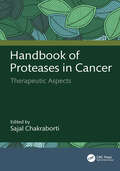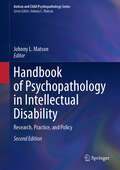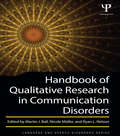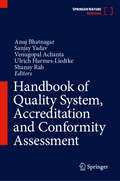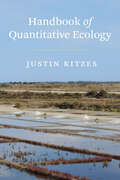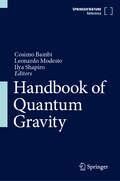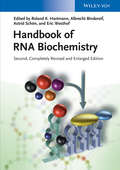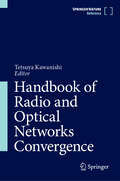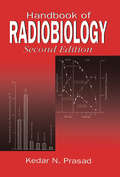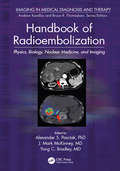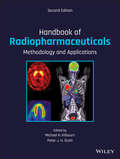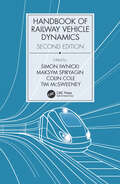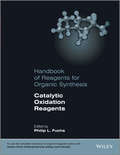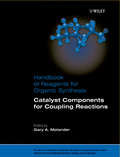- Table View
- List View
Handbook of Porous Silicon
by Leigh CanhamThis handbook updates the most fast-moving research areas of porous silicon research, introduces a range of brand new topics not reviewed before and is even more inclusive of worldwide centres of expertise. Rapid advances are being made in porous silicon anodes for lithium batteries, biodegradable nanoparticles and nanoneedles for medical therapy and imaging, energetics and bio-diagnostic techniques. A number of additional characterization and processing techniques are also reviewed for the first time. Experts from 10 additional countries are involved in the 2nd edition: China, Vietnam, Singapore, Malaysia, Saudi Arabia, Turkey, Netherlands, Switzerland, Belarus, and Brazil, making more than 40 countries in total. The handbook therefore covers expertise from every continent. Another new feature is a review dedicated to industrial activity. This second edition endeavours to provide the community with a truly comprehensive database and up-to-date commentary on this versatile nanostructured material.
Handbook of Potato Production, Improvement, and Postharvest Management
by Jai Gopal S.M. KhuranaPotatoes are a crucial food crop around the world, grown in nearly 150 countries. The Handbook of Potato Production, Improvement, and Postharvest Management compiles everything you need to know about potato crop production in one well-organized reference. Leading international authorities clearly discuss the biology, genetics, breeding, diseases, and effective approaches for improvement of crop and handling after harvest. This one-of-a-kind text explores, from interdisciplinary perspectives, every aspect of potato crop management from seed germination to end use while presenting the most current research available.
Handbook of Poylmer-Liquid Interaction Parameters and Solubility Parameters
by Allan F.M. BartonNow available for the first time, this valuable reference presents polymer solubility parameters and various polymer-liquid interaction parameters in an easy-to-use form. It critically evaluates and comprehensively compiles data from original sources. It presents these quantities polymer-by-polymer, alphabetically by polymer common chemical name, fully cross-referenced by systematic chemical names, alternative names and trade names. This one-of-a-kind handbook summarizes the relationship between the various quantities and their methods of determination. This resource is an absolute must for all who are interested in the chemical industry, specifically polymer chemistry, chemical engineering, applied chemistry, and physical chemistry.
Handbook of Precision Agriculture: Principles and Applications
by Ancha SrinivasanA thorough, critical, and up-to-date look at precision farming around the worldIn most developing countries, farming is the best safety net against hunger and keeping production costs under control without sacrificing crop yield is essential for survival. The Handbook of Precision Agriculture presents up-to-date research, field studies,
Handbook of Primate Behavioral Management
by Steven J. SchapiroKey features: Offers chapters by renowned experts which are comprised of three subunits: a theoretical discussion of the content area, a description of the methods employed to address the content area, and finally, and most importantly, a discussion of the ways that relevant aspects of the content area can be easily employed/adapted to enhance the behavioral management of NHPs Provides case studies that highlight the areas of expertise of the authors and emphasize ‘success stories’ that can be used to develop behavioral management strategies and build behavioral management programs Presents ‘Genera-specific’ chapters which focus on behavioral management strategies that, typically, are successfully employed with particular taxa of NHPs Includes a novel, pioneering ‘Product/services’ section that provides the producers of important technologies, equipment, and services with an opportunity to highlight the ways in which their products enhance the ability of their clients to manage the behavior of NHPs Illustrated with full color images and drawings throughout. The Handbook of Primate Behavioral Management (HPBM) fills a void in the scientific literature, providing those who work with nonhuman primates (NHPs) with a centralized reference for many issues related to the care and behavioral management of captive nonhuman primates. While there are numerous publications scattered throughout the literature that deal with the behavioral management of NHPs, this comprehensive handbook is the first single-source reference to summarize and synthesize this information. The HPBM is organized into six complementary parts starting with an introductory section. The book then provides in-depth coverage of content issues, applications and implementation, genera-specific chapters, technology-related questions involved in the behavioral management of NHPs, and a concluding section. Primate behavioral management is a topic that has recently generated a considerable number of primary publications in the scientific literature, mostly with an applied focus. Similarly, there are many primary publications currently available that address more basic issues related to the understanding of primate behavior. One of the principal goals of the HPBM is to highlight and synthesize basic science advances that can be adapted and applied to enhance the behavioral management of captive NHPs.
Handbook of Processes and Modeling in the Soil-Plant System
by Rolf Nieder Dinesh K. BenbiLearn to create and use simulation modelsthe most reliable and cost-effective tools for predicting real-world results! The Handbook of Processes and Modeling in the Soil-Plant System is the first book to present a holistic view of the processes within the soil-plant-atmosphere continuum. Unlike other publications, which tend to be more specialized, this book covers nearly all of the processes in the soil-plant system, including the fundamental processes of soil formation, degradation, and the dynamics of water and matter. It also illustrates how simulation modeling can be used to understand and forecast multiple interactions among various processes and predict their environmental impact. This unique volume assembles information that until now was scattered among journals, bulletins, reports, and symposia proceedings to present models that simulate almost all of the processes occurring in the soil-plant system and explores the results that these models are capable of producing. With chapters authored by experts with years of research and teaching experience, the Handbook of Processes and Modeling in the Soil-Plant System examines: physical, chemical, and biological soil processes the soil formation and weathering process and its modeling the impact of radioactive fallout on the soil-plant system soil degradation processes and ways to control them water and matter dynamics in the soil-plant system growth and development of crops at various levels of production the potentials and limitations of using simulation models Students, educators, and professionals alike will find the Handbook of Processes and Modeling in the Soil-Plant System an invaluable reference on the soil-plant-atmosphere system and an ideal tool to help develop an effective decision support system.
Handbook of Property Estimation Methods for Chemicals: Environmental Health Sciences
by Donald Mackay Robert S. BoethlingA complete restructuring and updating of the classic 1982 Handbook of Chemical Property Estimation Methods (commonly known as "Lyman's Handbook"), the Handbook of Property Estimation Methods for Chemicals: Environmental and Health Sciences reviews and recommends practical methods for estimating environmentally important properties of organic chemic
Handbook of Proteases in Cancer: Cellular and Molecular Aspects
by Sajal ChakrabortiThis handbook provides comprehensive coverage of the role of proteases and the associated biochemical pathways in cancer development and metastasis. Proteases make up about 2% of the human genome and play a critical role in the tumor microenvironment. Handbook of Proteases in Cancer: Cellular and Molecular Aspects introduces the major classes of proteases and the signal transduction mechanisms associated with cancer initiation and progression. It discusses the role of inflammation and immune responses in proteases-induced cancer. The book covers cancer-induced gene expression and apoptotic and necrotic pathways in cancer. This is useful for researchers and professionals in cancer research, biochemistry, and physiology. Key Features• Provides insights on the roles of proteases and anti-proteases in the tumor microenvironment.• Covers various cancer-induced apoptotic and necrotic pathways.• Discusses the mechanisms by which proteases induce an increase in inflammation, immuneresponse, and gene expression.• Covers the function of protease-activated receptors in cancer.• Reviews the different gene expression pathways and the ways they become erratic duringprotease-induced cancer.
Handbook of Proteases in Cancer: Therapeutic Aspects
by Sajal ChakrabortiThis handbook provides comprehensive coverage of the application of proteases in cancer therapy. Proteases make up to two percent of the human genome and play a critical role in the tumor microenvironment. The book delves into the applications of natural, synthetic, and non-coding RNAs in cancer therapy. It highlights how effective targeting of relevant proteases can help in cancer diagnosis and treatment. It covers the systems biology and bioinformatics approach in cancer drug development. The book is meant for researchers and professionals in cancer research, biochemistry, and physiology.
Handbook of Psychopathology in Intellectual Disability: Research, Practice, and Policy (Autism and Child Psychopathology Series)
by Johnny L. MatsonThe Second Edition of the handbook reflects the diversity of this complex subject matter, addressing its prevalence and presentation, testing methods, and treatment options. In addition to focusing on specific psychopathologies as they affect the course of intellectual disability (ID), several new chapters and significantly updated coverage span the field from in-depth analyses of psychosocial aspects of ID to promising new findings in genetics and the ongoing challenges of tailoring personalized care to meet individual client needs. Expert contributors bridge gaps between the evidence base and best practices for treating clients with ID across disciplines and discuss improved policy for maximum utility. Key areas of coverage include: Core etiological approaches in psychopathology and ID, including neuroimaging, behavioral phenotypes and genetic syndromes, psychological and social factors, and epilepsy. Comorbid psychopathologies (e.g., mood, anxiety, bipolar and personality disorders). Common clinical conditions (e.g., ADHD, autism, and behavior problems). Medical and psychological interventions (e.g., psychopharmacology) as well as community and inpatient services. The Handbook of Psychopathology in Intellectual Disability, Second Edition, is an essential reference for researchers, professors, and graduate students as well as clinicians, therapists, and other scientist-practitioners in developmental, school, and clinical child psychology, psychiatry, social work, rehabilitation medicine, public health, neuropsychology, and all related disciplines.
Handbook of Psychophysiology
by John T. Louis G. Cacioppo Tassinary Berntson Gary G.The Handbook of Psychophysiology, 3rd Edition is an essential reference for students, researchers, and professionals in the behavioral, cognitive, and biological sciences. Psychophysiological methods, paradigms, and theories offer entry to a biological cosmos that does not stop at skin's edge, and this essential reference is designed as a road map for explorers of this cosmos. The scope and coverage in the Handbook have expanded to include both a context for and coverage of the biological bases of cognitive, affective, social, and developmental processes and behavior. In addition to updated coverage of the traditional areas of psychophysiology, coverage of the brain and central nervous system has been expanded to include functional neuroimaging, event related brain potentials, electrophysiological source dipole localization, lesion methods, and transcranial magnetic stimulation. It also includes a section on cellular and humoral systems with attention to the communication across and interactions among cellular, immunological, endocrinological, and neural processes.
Handbook of Psychophysiology (3rd Edition)
by John T. Cacioppo Gary G. Berntson Louis G. TassinaryThe Handbook of Psychophysiology, 3rd Edition is an essential reference for students, researchers, and professionals in the behavioral, cognitive, and biological sciences. Psychophysiological methods, paradigms, and theories offer entry to a biological cosmos that does not stop at skin's edge, and this essential reference is designed as a road map for explorers of this cosmos. The scope and coverage in the Handbook have expanded to include both a context for and coverage of the biological bases of cognitive, affective, social, and developmental processes and behavior. In addition to updated coverage of the traditional areas of psychophysiology, coverage of the brain and central nervous system has been expanded to include functional neuroimaging, event related brain potentials, electrophysiological source dipole localization, lesion methods, and transcranial magnetic stimulation. It also includes a section on cellular and humoral systems with attention to the communication across and interactions among cellular, immunological, endocrinological, and neural processes.
Handbook of Qualitative Research in Communication Disorders
by Martin J. Ball Nicole Müller Ryan L. NelsonThis volume provides a comprehensive and in-depth handbook of qualitative research in the field of communication disorders. It introduces and illustrates the wide range of qualitative paradigms that have been used in recent years to investigate various aspects of communication disorders. The first part of the Handbook introduces in some detail the concept of qualitative research and its application to communication disorders, and describes the main qualitative research approaches. The contributions are forward-looking rather than merely giving an overview of their topic. The second part illustrates these approaches through a series of case studies of different communication disorders using qualitative methods of research. This Handbook is an essential resource for senior undergraduate and graduate students, researchers and practitioners, in communication disorders and related fields.
Handbook of Quality System, Accreditation and Conformity Assessment
by Sanjay Yadav Shanay Rab Anuj Bhatnagar Venugopal Achanta Ulrich Harmes-LiedtkeThis handbook comprehensively covers the topics of quality system, accreditation and conformity assessment. The main sections in this handbook covers topics such as conformity assessment, accreditation and certification, measurement requirements and conformity assessment, management systems, Product quality and safety and future of conformity assessment. This multidisciplinary handbook will be a useful reference for researchers and professionals across disciplines who are involved in conformity assessment activities.
Handbook of Quantitative Ecology
by Justin KitzesAn essential guide to quantitative research methods in ecology and conservation biology, accessible for even the most math-averse student or professional. Quantitative research techniques have become increasingly important in ecology and conservation biology, but the sheer breadth of methods that must be understood—from population modeling and probabilistic thinking to modern statistics, simulation, and data science—and a lack of computational or mathematics training have hindered quantitative literacy in these fields. In this book, ecologist Justin Kitzes addresses those challenges for students and practicing scientists alike. Requiring only basic algebra and the ability to use a spreadsheet, Handbook of Quantitative Ecology is designed to provide a practical, intuitive, and integrated introduction to widely used quantitative methods. Kitzes builds each chapter around a specific ecological problem and arrives, step by step, at a general principle through the process of solving that problem. Grouped into five broad categories—difference equations, probability, matrix models, likelihood statistics, and other numerical methods—the book introduces basic concepts, starting with exponential and logistic growth, and helps readers to understand the field’s more advanced subjects, such as bootstrapping, stochastic optimization, and cellular automata. Complete with online solutions to all numerical problems, Kitzes’s Handbook of Quantitative Ecology is an ideal coursebook for both undergraduate and graduate students of ecology, as well as a useful and necessary resource for mathematically out-of-practice scientists.
Handbook of Quantum Gravity
by Cosimo Bambi Ilya Shapiro Leonardo ModestoThe search for a theory of quantum gravity is one of the most important and fascinating problems in modern theoretical physics. While we do not have yet a complete theory of quantum gravity, significant advancements have been done in the past decades. In this handbook, every section is dedicated to a specific approach towards a theory of quantum gravity and is edited by the leading experts in the field. This book represents both a valuable resource for graduate students and an important reference for researchers in quantum gravity.
Handbook of RNA Biochemistry, 2nd Edition
by Astrid Schön Albrecht Bindereif Eric Westhof Roland K. HartmannThe second edition of a highly acclaimed handbook and ready reference. Unmatched in its breadth and quality, around 100 specialists from all over the world share their up-to-date expertise and experiences, including hundreds of protocols, complete with explanations, and hitherto unpublished troubleshooting hints. They cover all modern techniques for the handling, analysis and modification of RNAs and their complexes with proteins. Throughout, they bear the practising bench scientist in mind, providing quick and reliable access to a plethora of solutions for practical questions of RNA research, ranging from simple to highly complex. This broad scope allows the treatment of specialized methods side by side with basic biochemical techniques, making the book a real treasure trove for every researcher experimenting with RNA.
Handbook of Radio and Optical Networks Convergence
by Tetsuya KawanishiThis handbook provides comprehensive knowledge on device and system technologies for seamlessly integrated networks of various types of transmission media such as optical fibers and millimeter and THz waves to offer super high-speed data link service everywhere. The seamless integration of the knowledge of radio and optical technologies is needed to construct wired and wireless seamless networks. High-frequency bands such as millimeter-wave and THz-wave bands where super wideband spectra are available can offer high-speed data transmission and high-resolution sensing. However, the expected coverage is limited due to large wave propagation loss. Thus, convergence of radio and optical links is indispensable to construct worldwide networks. The radio and optical technologies share the same physics and are closely related to each other but have been developed independently. Therefore, there is a big gap between these two fields. Bridging the two fields, this handbook is also intended as a common platform to design integrated networks consisting of wireless and wired links. Full coverage of wireless and wired convergence fields ranging from basics of device and transmission media to applications allows the reader to efficiently access all the important references in this single handbook. Further, it also showcases state-of-the-art technology and cases of its use.
Handbook of Radiobiology
by Kedar N. PrasadThis handbook presents the most current information on the effects of ionizing radiation on mammalian cells, with emphasis on human tissues. The dose-effect relationship is emphasized in a quantitative manner. The book contains up-to-date data on the late effects of low levels of radiation on humans. It also provides some of the late consequences of radiation therapy detected among cancer survivors.
Handbook of Radioembolization: Physics, Biology, Nuclear Medicine, and Imaging (Imaging in Medical Diagnosis and Therapy)
by Alexander S. Pasciak, J. Mark McKinney and Yong C. BradleyRadioembolization is a widely used treatment for non-resectable primary and secondary liver cancer. This handbook addresses the radiation biology, physics, nuclear medicine, and imaging for radioembolization using Yttrium-90 (90Y) microspheres, in addition to discussing aspects related to interventional radiology. The contents reflect on and off-label treatment indications, dose-response relationships, treatment-planning, therapy optimization, radiation safety, imaging follow-up and many other facets of this therapy necessary for both novice and advanced users alike.
Handbook of Radiopharmaceuticals: Methodology and Applications
by Michael R KilbournThe thoroughly updated new edition of the authoritative reference in Radiopharmaceutical Sciences The second edition of Handbook of Radiopharmaceuticals is a comprehensive review of the field, presenting up-to-date coverage of central topics such as radionuclide production, synthetic methodology, radiopharmaceutical development and regulations, and a wide range of practical applications. A valuable reference work for those new to the Radiopharmaceutical Sciences and experienced professionals alike, this volume explores the latest concepts and issues involving both targeted diagnostic and therapeutic radiopharmaceuticals. Contributions from a team of experts from across sub-disciplines provide readers with an immersive examination of radiochemistry, nuclear medicine, molecular imaging, and more. Since the first edition of the Handbook was published, Nuclear Medicine and Radiopharmaceutical Sciences have undergone major changes. New radiopharmaceuticals for diagnosis and therapy have been approved by the FDA, the number of clinical PET and SPECT scans have increased significantly, and advances in Artificial Intelligence have dramatically improved research techniques. This fully revised edition reflects the current state of the field and features substantially updated and expanded content. New chapters cover topics including current Good Manufacturing Practice (cGMP), regulatory oversight, novel approaches to quality control—ensuring that readers are informed of the exciting developments of recent years. This important resource: Features extensive new and revised content throughout Covers key areas of application for diagnosis and therapy in oncology, neurology, and cardiology Emphasizes the multidisciplinary nature of Radiopharmaceutical Sciences Discusses how drug companies are using modern radiopharmaceutical imaging techniques to support drug discovery Examines current and emerging applications of Positron Emission Tomography (PET) and Single Photon Emission Computed Tomography (SPECT) Edited by recognized experts in radiochemistry and PET imaging, Handbook of Radiopharmaceuticals: Radiochemistry and
Handbook of Railway Vehicle Dynamics, Second Edition
by Maksym Spiryagin Colin Cole Tim McSweeney Simon IwnickiHandbook of Railway Vehicle Dynamics, Second Edition, provides expanded, fully updated coverage of railway vehicle dynamics. With chapters by international experts, this work surveys the main areas of rolling stock and locomotive dynamics. Through mathematical analysis and numerous practical examples, it builds a deep understanding of the wheel-rail interface, suspension and suspension component design, simulation and testing of electrical and mechanical systems, and interaction with the surrounding infrastructure, and noise and vibration. Topics added in the Second Edition include magnetic levitation, rail vehicle aerodynamics, and advances in traction and braking for full trains and individual vehicles.
Handbook of Reagents for Organic Synthesis
by Philip L. FuchsThe Handbook of Reagents for Organic Synthesis: Catalytic Oxidation Reagents is part of the Handbook for Reagents for Organic Synthesis series, making use of the leading reagent database e-EROS. It provides concise and informative articles written by experts in the area and provides comprehensive referencing to the original literature. As is the standard format for EROS, each article also contains an overview of the synthesis and physical properties of the catalysts, conditions for its storage, and purification methods. The Handbook compiles essential reagents in this area, starting with an introductory section discussing the main classes of oxidation catalysts, followed by an alphabetical list of reagents, with an attempt to keep families of catalysts organized by related chemistry for ease of use. The Handbook concludes with a list of contributors and a detailed index.The Handbook of Reagents for Organic Synthesis: Catalytic Oxidation Reagents if of interest for everyone engaged in the area of sustainable chemistry, fuel alternatives research for the generation of energy, and synthetic chemists working in pharmaceutical industries and medicinal chemistry.Key features:Builds on the success of the previously published Handbooks of Reagents for Organic SynthesisOxidations are the most frequently used steps in organic synthesisCatalysts for oxidation reactions are the key for green or sustainable chemistryOxidation, the addition of oxygen to biomolecules, is key for the metabolism of humans and animalsOxidations of carbohydrates from simple organic compounds are the key for new renewable energies
Handbook of Reagents for Organic Synthesis, Catalyst Components for Coupling Reactions
by Gary A. MolanderThe long awaited Handbook for all synthetic chemists working on coupling reactions, compiling all major catalyst components in use in the area.Consists of a compilation of articles taken from the EROS database, with the inclusion of about 20 newly commissioned catalysts/pre-catalysts/ligands that have made an impact in this area of synthetic organic chemistry.Includes catalyst systems used in Heck, Kumada-Tamao-Corriu, Suzuki-Miyaura, Hiyama-Hatanaka, Negishi, Migita-Kosugi-Stille, Buchwald-Hartwig, and Tsuji-Trost coupling reactions.
Handbook of Reagents for Organic Synthesis, Reagents for Radical and Radical Ion Chemistry
by David CrichRadicals and radical ions are important intermediates with wide use in organic synthesis. The first book to concentrate on reagents for the creation and use of radicals and radical ions, this new volume in the Handbooks of Reagents for Organic Synthesis series compiles articles taken from the e-eros database, on reagents for use in radical and radical chemistry, to help the chemist in the lab choose the right reagents. Reflecting the enormous growth of radical chemistry over the past ten years, this is an essential guide for all synthetic chemists.
